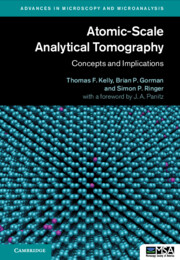Book contents
- Atomic-Scale Analytical Tomography
- Advances in Microscopy and Microanalysis
- Atomic-Scale Analytical Tomography
- Copyright page
- Dedication
- Contents
- Foreword
- Atomic-Scale Analytical Tomography (ASAT)
- Preface
- Acknowledgments
- Introductory Section
- Core Section
- 4 Has ASAT Been Achieved?
- 5 How ASAT Might Be Achieved
- 6 Instrumentation for ASAT
- 7 Practical ASAT
- 8 Toward Real-Space Crystallography
- 9 Experimental Metrics for ASAT
- Implications Section
- Index
- References
5 - How ASAT Might Be Achieved
from Core Section
Published online by Cambridge University Press: 03 March 2022
- Atomic-Scale Analytical Tomography
- Advances in Microscopy and Microanalysis
- Atomic-Scale Analytical Tomography
- Copyright page
- Dedication
- Contents
- Foreword
- Atomic-Scale Analytical Tomography (ASAT)
- Preface
- Acknowledgments
- Introductory Section
- Core Section
- 4 Has ASAT Been Achieved?
- 5 How ASAT Might Be Achieved
- 6 Instrumentation for ASAT
- 7 Practical ASAT
- 8 Toward Real-Space Crystallography
- 9 Experimental Metrics for ASAT
- Implications Section
- Index
- References
Summary
Based on our preceding discussions of atomic-resolution characterization techniques in Chapter 4, no technique has yet achieved ASAT. Combining information from FIM or (S)TEM along with APT has demonstrated some very promising results, and each combination seems to be a likely path toward ASAT. In this chapter, we propose how ASAT might be achieved using correlative and/or combined techniques such as (S)TEM + APT. Such a combination would allow several routes for determination of the ion transfer function, or how imaging occurs during an APT experiment. If we can determine the transfer function with high-enough fidelity, we make the argument that it should be possible to achieve ASAT using a combination of (S)TEM and APT with inputs from simulations.
Keywords
- Type
- Chapter
- Information
- Atomic-Scale Analytical TomographyConcepts and Implications, pp. 77 - 97Publisher: Cambridge University PressPrint publication year: 2022

